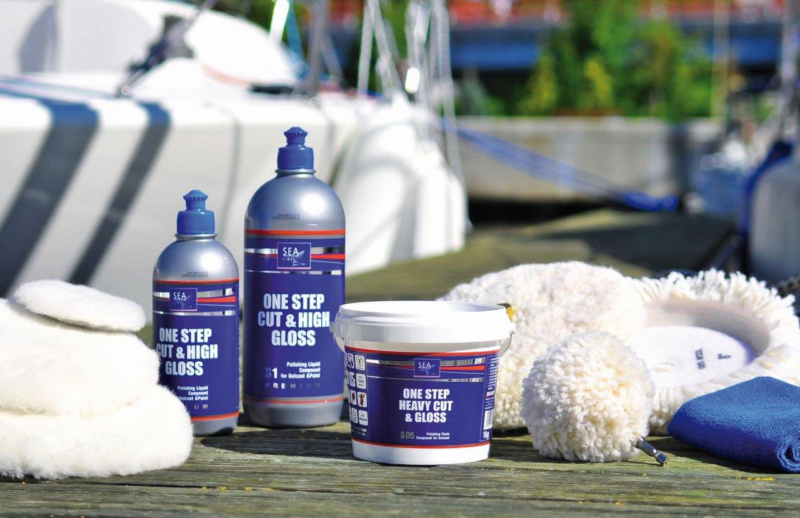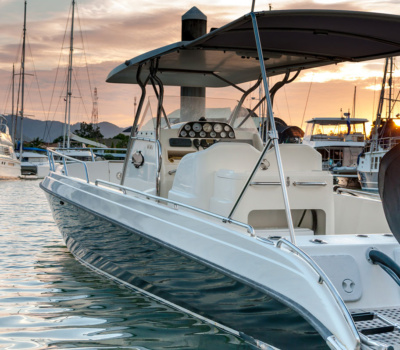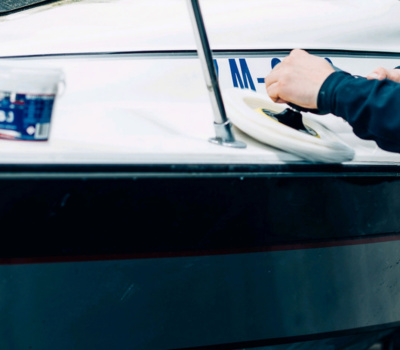Polishing systems meet all stages of production, as well as during repair work, renovations or treatments.
Different hardness of materials, colors and expected finish level require the use of different cutting force polishing compounds and specialized heads, sponges or fur.

The table shows the proper selection of Sea-Line polishing compounds for various types of polishing heads.
| PRODUCT : | SEA-LINE® S0 | SEA-LINE® SO5 | SEA-LINE® S1 | SEA-LINE® S1 PREMIUM | SEA-LINE® S2 | |||||||||||||||||
| CUTTING FORCE | 8 / 10 | 9 / 10 | 6 / 10 | 8 / 10 | 2 / 10 | |||||||||||||||||
| GLOSS LEVEL | 6 / 10 | 8 / 10 | 6 / 8 | 9 / 10 | 10 / 10 | |||||||||||||||||
| PAPER GRADATION | BRIGHT COLOURS AND SURFACES OF LOW OR AVERAGE HARDNESS | |||||||||||||||||||||
| P800⇒ | P800⇒ | P1200⇒ | P800⇒ | P3000⇒ | ||||||||||||||||||
| DARK COLOURS AND SURFACES OF HIGH HARDNESS | ||||||||||||||||||||||
| P1200⇒ | P1200⇒ | P1500⇒ | P1200⇒ | P3000⇒ | ||||||||||||||||||
| MATERIALS DIFFICULT TO POLISH (PLEXI, POLICARBONATES) | ||||||||||||||||||||||
| X | P1500⇒ | P2000⇒ | P1500⇒ | X | ||||||||||||||||||
| UV PROTECTION LEVEL | X | X | VERY LOW | X | AVERAGE | |||||||||||||||||
| MANUAL LABOUR | √ | √ | √ | √ | √ | |||||||||||||||||
| ROTARY MACHINE | √ | √ | √ | √ | √ | |||||||||||||||||
| ORBITAL MACHINE | OPTIONAL ( P2000⇒) | OPTIONAL ( P2000⇒) | X | OPTIONAL ( P2000⇒) | √ | |||||||||||||||||
| TYPE OF SURFACES | ||||||||||||||||||||||
| TOOL GELCOAT | √ | √ | √ | √ | X | |||||||||||||||||
| GELCOAT | √ | √ | √ | √ | √ | |||||||||||||||||
| POLYURETHANE PAINTS | X | OPTIONAL | √ | √ | √ | |||||||||||||||||
| INDUSTRIAL PAINTS | √ | √ | √ | √ | √ | |||||||||||||||||
| OTHER PAINTS | OPTIONAL | √ | √ | √ | √ | |||||||||||||||||
| PLEXI, POLICARBONATES | OPTIONAL | √ | √ | √ | OPTIONAL | |||||||||||||||||
| CHOOSING APPROPRIATE APPLICATOR SEA-LINE® | ||||||||||||||||||||||
| SHEEP WOOL FOR GELCOAT SEA-LINE® | X | |||||||||||||||||||||
| SHEEP WOOL POLISHING BALL (∅80mm) | X | |||||||||||||||||||||
| LAMBSWOOL TYPE D | X | |||||||||||||||||||||
| LAMBSWOOL TYPE mm | ||||||||||||||||||||||
| “BRAYT „PROFI” POLISHING SPONGE | X | |||||||||||||||||||||
| “BRAYT „FINISH” POLISHING SPONGE | ||||||||||||||||||||||
| POLISHING SPONGE | WHITE | X | ||||||||||||||||||||
| PINK | X | |||||||||||||||||||||
| YELLOW | ||||||||||||||||||||||
| BLACK | X | X | ||||||||||||||||||||

We are expanding our offer by introducing two new products that will provide boat enthusiasts

Come and join us at METSTRADE 2023, METSTRADE the best event for marine industry professionals,

Visit us and our production plant without traveling

New in the 2023 season is a new polishing wool The new black and white
We recommend to always sand the surface between applying two different products to ensure uniform surface roughness and adhesion of subsequent layers. The sanded surface should also be cleaned and degreased.
We do not recommend using universal thinners. The use of a thinner with an unknown composition may result in loss of adhesion, lack of proper flow of paint and varnish defects.
Yes, you can mix Sea-Line polyurethane paints. The only difference are the pigments of polyurethane paints that determine the color of the paint. But remember to keep the right proportions of base, hardener and thinner.